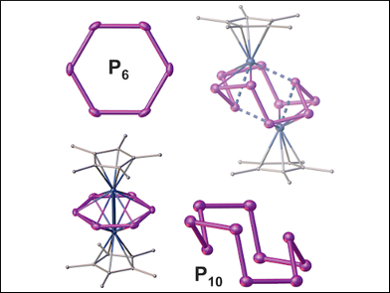The isolation of the all-phosphorus analogue of benzene in 1985 is viewed as a milestone in inorganic chemistry. Various other stabilized polyphosphorus frameworks have been reported in the literature, although their investigation has been hampered by low yields and many have only been explored by theoretical techniques.
Manfred Scheer, University of Regensburg, Germany, and colleagues investigated the synthesis of cyclo-P6 complexes again, using higher thermolysis temperatures and with the goal of studying the coordination chemistry of these compounds. In addition to a dramatically increased 64 % yield of the intended cyclo-P6 complex, they also isolated traces of the novel complex [(Cp*Mo)2(μ-P10)], which contains the unprecedented ligand P102− and represents the largest polyphosphorus cycle synthesized to date.
Single-crystal X-ray analysis revealed that [(Cp*Mo)2(μ-P10)] can be formally described as a cyclo-decaphosphatetraenediide dianionic P10 ligand stabilized by two [Cp*Mo]+ fragments. The researchers then went on to study the reactivity of their target cyclo-P6 complex toward various metal cations and obtained supramolecular inorganic analogues of graphene.
- Redox and Coordination Behavior of the Hexaphosphabenzene Ligand in [(Cp*Mo)2(μ,η6:η6-P6)] Towards the “Naked” Cations Cu+, Ag+, and Tl+,
Martin Fleischmann, Fabian Dielmann, Laurence J. Gregoriades, Eugenia V. Peresypkina, Alexander V. Virovets, Sebastian Huber, Alexey Y. Timoshkin, Gábor Balázs, Manfred Scheer,
Angew. Chem. Int. Ed. 2015.
DOI: 10.1002/anie.201506362
|
The novel phosphorus-rich complex [(Cp*Mo)2(μ-P10)] with the unprecedented P102− ligand was isolated and reported to be the largest polyphosphorus cycle to date. |

 Find more world records from all branches of chemistry on the Records and Challenges platform of
Find more world records from all branches of chemistry on the Records and Challenges platform of 


